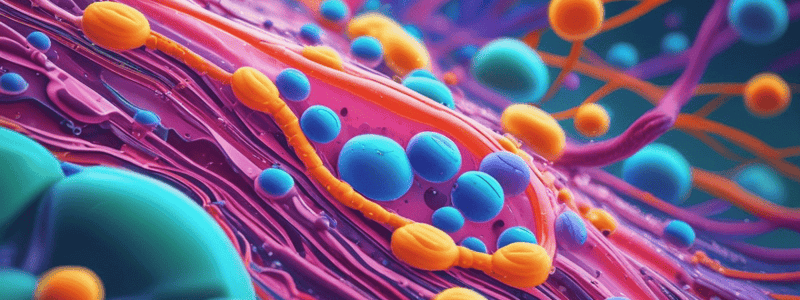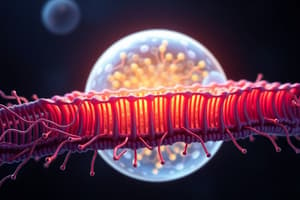Podcast
Questions and Answers
What is the main function of the cell membrane?
What is the main function of the cell membrane?
- To regulate the movement of materials in and out of the cell (correct)
- To provide structural support to the cell
- To store genetic information
- To facilitate cellular respiration
Which of the following is NOT a component of the cell membrane?
Which of the following is NOT a component of the cell membrane?
- Nucleic acids (correct)
- Proteins
- Phospholipids
- Carbohydrates
What is the fluid mosaic model used to explain?
What is the fluid mosaic model used to explain?
- The process of cell division
- The structure of the nucleus
- The structure and properties of the cell membrane (correct)
- The movement of materials across the cell membrane
Which of the following is NOT a function of the cell membrane?
Which of the following is NOT a function of the cell membrane?
What is the structure of the cell membrane composed of?
What is the structure of the cell membrane composed of?
What is the primary function of the cell membrane?
What is the primary function of the cell membrane?
Which of the following molecules are found in the cell membrane?
Which of the following molecules are found in the cell membrane?
What is the function of cholesterol in the cell membrane?
What is the function of cholesterol in the cell membrane?
What is the primary role of integral proteins in the cell membrane?
What is the primary role of integral proteins in the cell membrane?
What is the function of the glycocalyx in the cell membrane?
What is the function of the glycocalyx in the cell membrane?
What is the primary role of GLUT4 transport proteins in relation to glucose regulation?
What is the primary role of GLUT4 transport proteins in relation to glucose regulation?
How does the cell membrane act as a transducer?
How does the cell membrane act as a transducer?
What is the role of growth hormone in cell signaling?
What is the role of growth hormone in cell signaling?
What is the role of integral proteins in the cell membrane in relation to cell movement and adhesion?
What is the role of integral proteins in the cell membrane in relation to cell movement and adhesion?
According to the passage, what is the primary function of the cell membrane?
According to the passage, what is the primary function of the cell membrane?
Flashcards are hidden until you start studying
Study Notes
Cell Membrane Structure
- The cell membrane is a thin, flexible barrier composed of two layers of phospholipids, proteins, carbohydrates, and cholesterol.
- The phospholipid bilayer is the main component, with hydrophobic tails facing inward and hydrophilic heads facing outward.
- Cholesterol is present in the membrane, contributing to its flexibility and fluidity.
Functions of the Cell Membrane
- The primary function is to separate the cell from its environment and regulate what enters and leaves the cell (selective permeability).
- Maintains homeostasis by creating stable internal conditions despite changing external environments.
- Regulates transport of materials, cellular movement, and adhesion.
- Plays a crucial role in cell signaling and division.
Phospholipids
- Amphipathic lipids with hydrophobic tails and hydrophilic heads.
- Arranged in a bilayer, with tails facing inward and heads facing outward.
- Contribute to the membrane's fluidity and selective permeability.
Proteins in the Cell Membrane
- Two types: integral proteins (span the membrane) and peripheral proteins (attached to the outside).
- Functions include:
- Cell signaling
- Anchoring cells to each other and the extracellular matrix
- Cell movement
- Transport of materials
- Enzymatic reactions
- Transport proteins can act as pumps or channels to regulate material transport.
- Enzymatic proteins can carry out chemical reactions, such as phosphorylation.
Carbohydrates in the Cell Membrane
- Attached to the outside of the cell membrane as the glycocalyx.
- Functions include:
- Cell recognition and identification
- Cellular adhesion to the extracellular matrix
- Cushioning the plasma membrane
Studying That Suits You
Use AI to generate personalized quizzes and flashcards to suit your learning preferences.




